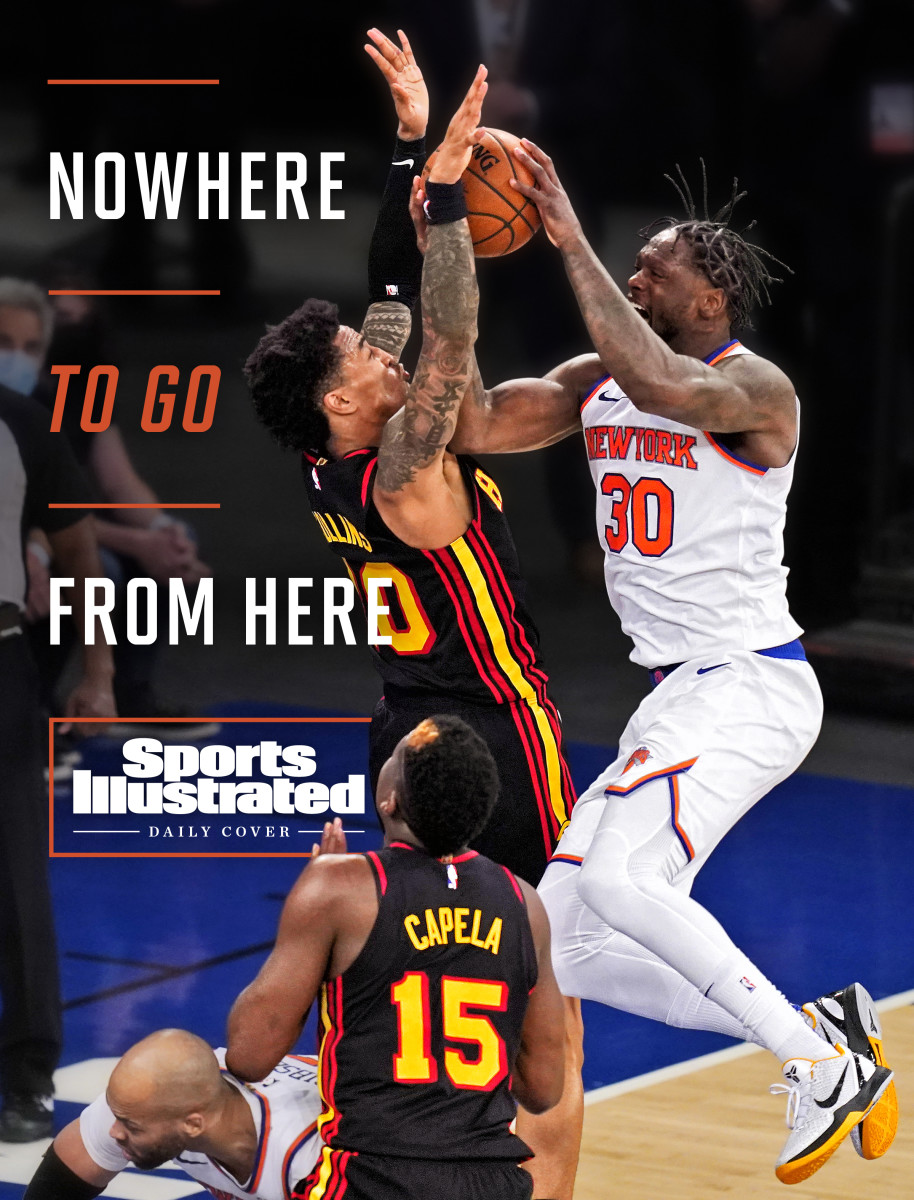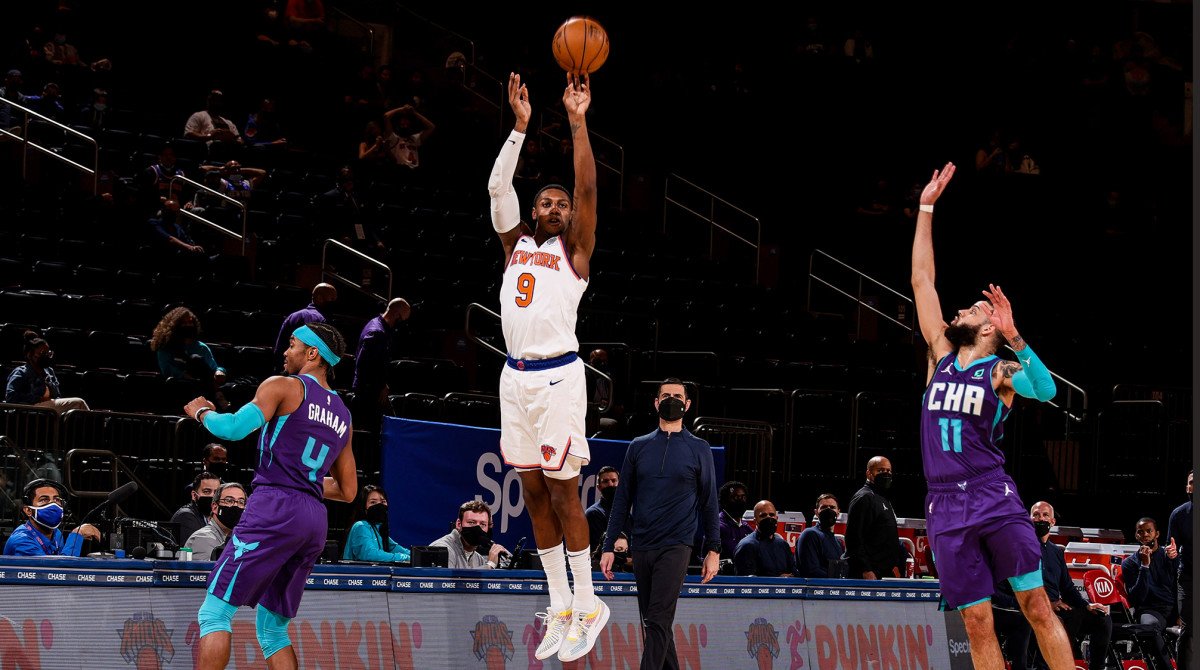What If This Is As Good As It Gets?

At times, comparisons between the 2021 Knicks and their 1990s predecessors seem a bit overblown.
In contrast with the current club, those Knicks—who mimicked the Bad Boys Pistons and were the last of their kind—regularly led the NBA in flagrants and technicals. They weren’t merely inclined to play with a nasty streak; they were required to. After laying out opposing players with unforgiving physicality, then coach Pat Riley had an established, preemptive warning: Any player who tried to help up a fallen opponent would be fined. From 1992 to ’99, they were a perennial contender to win the title, but they never quite got there.
Still, even if those brutish elements are missing, one of the more defining characteristics—the club’s otherworldly work ethic, particularly on defense—appears to be similar. It’s what the team’s undyingly loyal fan base has craved for decades, after growing accustomed to that sort of output for 10 straight years. And the mindset has been a driving force behind the Knicks’ surprise run to reach the postseason.
But in a way, that pedal-to-the-floor mentality may very well carry some unintended consequences, too. Specifically, it raises the question of whether these Knicks, who’ve already been giving maximum effort for months and now trail the Hawks 3–1 after Sunday’s 113–96 loss at State Farm Arena, can realistically raise their play like a number of teams do during the playoffs.

Several Knicks—including star forward Julius Randle, second-leading scorer RJ Barrett, backup guard Derrick Rose and swingman Reggie Bullock—shot almost improbably well from the perimeter during the team’s 41–31 campaign. According to NBA.com’s John Schuhmann, those four saw the NBA’s second, 10th, 11th and 13th biggest spikes in three-point percentage since last year among players with 100 tries from deep in each of the past two years. Coach Tom Thibodeau deserves credit. (As does assistant Darren Erman.) Upon being hired, he spoke with the analytics department about squeezing out more production from deep, prompting the club to use a four-point line at practices while making more frequent use of the corners. The Knicks, who just last year ranked 21st in the NBA in corner-three frequency, took a greater share of their threes from the corners than any other club this season.
Rank | Player, Team | 2019–20 | 2020–21 | Difference |
|---|---|---|---|---|
2 | Julius Randle, NYK | .277 | .411 | +.134 |
10 | RJ Barrett | .320 | .402 | +.082 |
11 | Derrick Rose, Det-NYK | .306 | .388 | +.082 |
13 | Reggie Bullock | .333 | .410 | +.077 |
But with an emergence this sudden—especially with Randle, the Most Improved Player, whose shooting breakthrough was almost unprecedented—it was always fair to wonder whether those sorts of numbers could were sustainable long-term, or against playoff-caliber defense. And if the first four games against Atlanta are any indication, something’s clearly shifted. Rose has played incredibly well. But Barrett, New York’s second-leading scorer during the season, has shot just 39.6% from the floor, and 27.3% from deep versus the Hawks. Bullock went scoreless (0 for 4) in Sunday’s defeat, and is shooting 37.9% in the series.
Then there’s Randle, who’s looked like a completely different player—in the worst possible way. The forward, full of swagger and regularly scoring against double-teams in the regular season, has been tentative and uncomfortable all series. Even in the few moments he’s been left relatively open, he’s occasionally looked to pass the ball. On Sunday, when he shot 7-for-19 and scored 23 points—somehow his best performance of the series thus far—he had a play in the third quarter where he got Atlanta’s Kevin Huerter in the air on a pumpfake, then dribbled into the paint. The Hawks had just subbed out stud rim protector Clint Capela, so a rumbling freight train like Randle looked like an even safer bet to score as he closed in toward the basket. But John Collins went vertical at the rim, and Randle’s attempt glanced off the iron. He had an opportunity to tip home his own miss before any other player leapt for the rebound, but that was off the mark, too. He ended up with the ball a third time, then fumbled it out of bounds.
Randle averaged 37.3 points per game on 58.3% shooting against the Hawks during the season, but the team’s No. 1 option is now averaging 16.8 points on 27.4% shooting for the series—numbers that, if they hold, indicate the Knicks have little chance of coming back to knock off Atlanta.
In a way, even Rose’s success has even created challenges for the Knicks at times. Because Thibodeau opted to move his longtime point guard into the starting lineup in Game 3, the team’s bench looked lost on offense without him during the second quarter, which turned out to be difference in that contest.
The Knicks have talent, but not in abundance. Stretching Rose’s minutes and moving him into the starting lineup was like robbing Peter to pay Paul. It plugged one clear hole, but quickly created another.
There may not always be enough putty on defense, which Thibodeau stresses more than perhaps any other coach. (Any given night, you can hear him shouting instructions, loudly, to his players from the sideline about how to play an opposing team’s pick-and-roll.) Without the injured Mitchell Robinson, New York has a young ace-defending guard who hardly plays (Frank Ntilikina) and an athletic beanpole of a backup big (rejection specialist Nerlens Noel) who at times lacks the stoutness to hang with the biggest centers. After them, though, the Knicks—23rd in defensive efficiency last year with virtually the same roster—are more or less average from top to bottom in terms of individual defending. That makes it even more remarkable that they’ve managed to build a top-five defense with that group in 2021.
Under Thibodeau’s direction, the Knicks operate with a sort of synchronized chaos. During the regular season, they were masters at forcing the ball out of playmakers’ hands, making second, third and fourth efforts. When they sent aggressive double teams at post players, opponents scored a league-low .796 points per possession in those scenarios, according to Synergy Sports. New York has been taught to funnel players toward help defenders, which, when done right, makes it challenging to find a clean shot or easy pass to make. Would-be spot-up shooters typically find themselves flustered, swinging the ball to the next open man or putting it on the deck because of how hard the Knicks race at them on the perimeter.
Knicks fans have long been accustomed to seeing their team give up wide-open threes, but now it’s often strategic. The Knicks are fine giving up an open look to someone like Atlanta’s Cam Reddish (26.2% from deep, and 28.6% against New York). But in turn, they’ll generally blanket the likes of Brooklyn’s Joe Harris, who shot a league-best 47.5% in 2021, and hit 42.1% of his tries against New York.
The team’s high-speed closeouts—and its ability to occasionally induce shots from poor shooters—led to the Knicks’ finishing the campaign with the lowest opponent’s three-point percentage in the NBA, at 33.7%. (League average is 36.7%.) Overall, New York held foes to 44.0% from the field, and 104.7 points per game—both league lows. It marks the first time since 1999–2000, under Jeff Van Gundy, that the Knicks ranked best in both categories. (New York also accomplished the feat in 1992–93 and ’93–94 with Riley in charge. The club owned the NBA’s best defensive efficiency rate three straight years under him.)

Consistently playing that way isn’t easy, though. “It’s some hard work,” Barrett said of the commitment.
Barrett understands this better than anyone. Over the course of the season, he logged more than 192 miles on the court, more than any other NBA player. Randle tracked 188 miles. By contrast, Kevin Huerter, the high man on the Hawks, traveled just 158 miles. Star Trae Young covered only 155. John Collins and and Clint Capela finished with 138.7 and 137.1, respectively. (Part of this was Barrett and Randle’s playing virtually every game, which only a handful of players leaguewide managed to do this year.)
For better or worse, it’s yet another way in which these Knicks resemble the ones from decades prior.
Players from that generation—one with no concept of rest or load management—approached practices in the same cut-throat fashion they did the games. “I still remember when I got traded to the Knicks. I was working out at UCLA with Magic [Johnson] and [James] Worthy,” Doc Rivers recalls of being dealt from the Clippers to New York in 1992. “They said, ‘You’re in trouble, bro.’ They loved Riles. But they said the intensity of the workouts was going to kill me and kill my career. They said, ‘Your career is done.’ ”
Rivers, 32 years old and the Knicks’ starting point guard back then, tore his ACL the next year. And New York, outdueled by Michael Jordan and turned back in the Finals twice, never won a title in that era.
The situations are obviously different for many reasons. Dating back to his time with Chicago, Thibodeau has faced questions about the heavy minutes he saddles his best players with. This season, whenever he’s been asked about the workload for Barrett and Randle, Thibodeau has said they’re both young players, and that he’s often proactive about giving them days off during practice sessions.
But looking beyond injuries and fatigue, there remains the broader issue of pacing in an effort to have a team peak during the playoffs.
Two schools of thought exist. The glass-half-full approach would suggest a team like the Knicks is better off for having played this way all season, because there’s no need to acclimate to a new level of intensity in the postseason. The effort is built in at this point, and their lead guys have played significant minutes all along. Yet it’s easy to see how a team like the Hawks—battered by injury for much of the season, but now finally whole again—could improve by extending their best players’ minutes and locking in defensively. (Both teams finished the season on fire. Under coach Nate McMillan, who took over midway through the year, the resurgent Hawks went 25–11 after the All-Star Game. Meanwhile, the Knicks reeled off a season-best nine-game win streak in April and closed out the year with 16 wins in their last 20 games.)

It’s obviously a bit strange to wrestle over the question of whether the Knicks have played too hard for their own good in recent months. That we’re even talking about it at all speaks to how much the club has overachieved. New York entered the season with the league’s lowest payroll, and even lower expectations following last year’s 21–45 mark. This is a franchise that’s lost more than any other the past two decades: one made up of a handful of young, key contributors who still need to learn the right work habits.
Asked whether there’s still more magic and the players can squeeze out of this season, Thibodeau said there was. “I think we will [make the adjustments]. I know how they work. Their attitude is upbeat, and their work ethic is second to none,” Thibodeau said after the Game 3 loss.
Perhaps more than anyone, Knicks fans always have a thirst for hard-working teams that embrace full effort and floor burns. After 20 years, the city finally has another cold glass of water. But whether that glass is half-empty or half-full is a moot point for the Knicks right now. Because if you’ve already poured everything you have into the regular season, that high-water mark probably won’t be enough to advance come playoff time.
More NBA Playoff Coverage:
• Chris Paul Is Back, and He Brought the Suns With Him
• The Mental Peril of This NBA Season
• Atlanta Is Falling in Love With Trae Young
